Referees’ Home-Bias in Football Disappears without Audience [Study]
We analyzed referees’ performances in 1283 games from the top four European football leagues in 2019-20 to bring you these findings.
Key Findings:
- Home-team advantage has disappeared from refereeing decisions since leagues have restarted.
- The number of fouls per game has remained consistent to pre-COVID matches, and while yellow cards for home teams has also stayed consistent, the average number of yellow cards per game awarded to away sides has decreased 20.2% from 2.43 to 1.94.
- In three out of four major leagues, referees are giving fewer yellow cards without an audience. In the Premier League alone the number of yellow cards per game has dropped 28%.
Comparison of yellow cards in various leagues
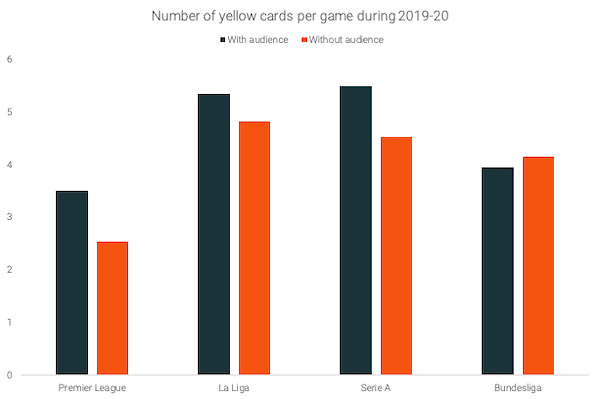
In three out of the four major leagues, the average number of yellow cards has decreased. The drop is the most obvious in the Premier League where the number of yellow cards has gone down from 3.5 cards/game to 2.53 cards/game (-28%).
In La Liga, the average count has gone down from 5.34/game to 4.83/game (-9.6%), and in Serie A, from 5.5/game to 4.52/game (-17.82%).
Only the Bundesliga has displayed the opposite trend with the average yellow card count increasing from 3.95/game to 4.15/game (+5.1%).
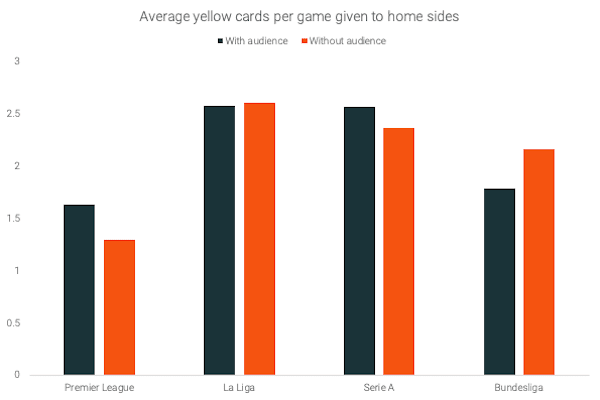
When we focus only on home sides, we fail to see a uniform trend in all leagues. In the Premier League, the average has gone down from 1.63 cards/game to 1.29 cards/game (-20.8%). In La Liga, we don’t see any significant difference as the average has increased from 2.57/game to 2.60/game.
In Serie A, the average has decreased from 2.56/game to 2.36/game (-7.8%) while Bundesliga has witnessed an increase from 1.78/game to 2.16/game (+21.34%).

This graph paints an interesting picture of all leagues. We see a uniform trend in all leagues that away sides have received fewer yellow cards without an audience present in stadiums. When we look at overall figures from all leagues, we see a 20.2% decrease in the number of yellow cards awarded to away sides.
In the Premier League, the average has gone down from 1.88 cards/game to 1.24 cards/game. This is an incredible decrease of 34% in yellow cards dished out to away sides.
In La Liga, the average has decreased from 2.77 cards/game to 2.23 cards/game (-19.5%). Serie A has witnessed a drop from 2.94 to 2.16 (-26.5%). In the Bundesliga, away sides received 1.99 cards/game without an audience as compared to 2.17 cards/game with an audience (-8.3%).
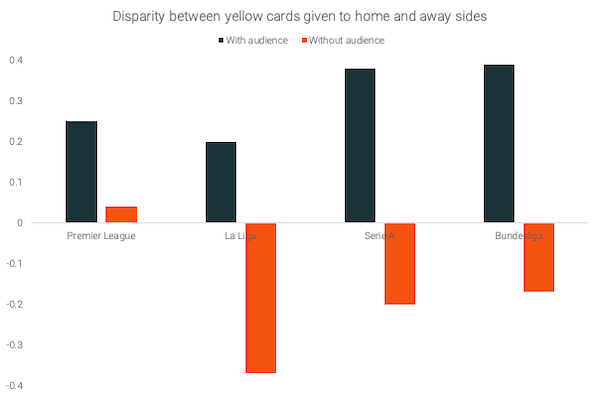
We subtracted the average count of yellow cards given to away sides from the average count of home sides to compare the disparity with and without an audience.
It’s clear to see that with the audience present, home sides had an advantage over away sides in all leagues. However, post-COVID, the home-advantage has disappeared from all leagues. In the Premier League, we see that the disparity is almost absent, but in all other leagues, we see that the advantage has turned into a disadvantage for home sides.
Comparison of fouls in various leagues
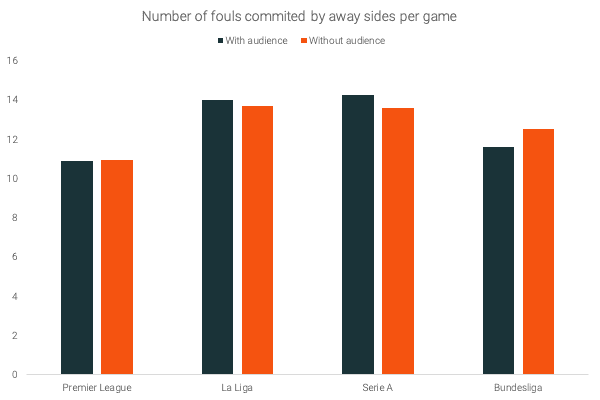
We also compared the number of fouls given to home and away sides to see whether the absence of crowds has had any impact on the overall team fouls and aggressive play.
The above graph confirms that there hasn’t been any significant difference without an audience. Only the Bundesliga displays a worth-mentioning change from 22.68 fouls/game to 25.27 fouls/game(+11.4%).
Fouls to yellow cards comparison
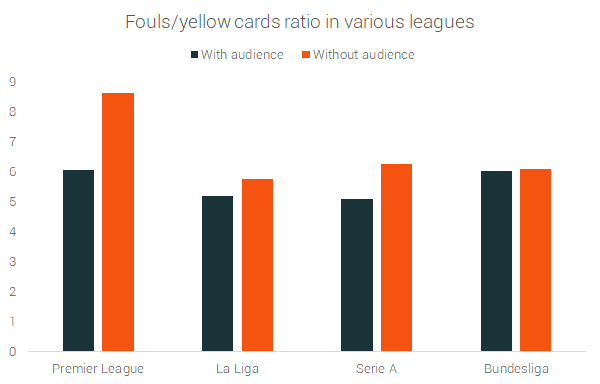
In our last section, we have compared the ratio of fouls to yellow cards from the four leagues. We see that the ratio has significantly increased in all leagues, but Bundesliga.
In the Premier League, the ratio has increased the most, from 6.04 to 8.6 (+42.4%). In La Liga, it has increased from 5.17 to 5.74 (+11.04%) and in Serie A, from 5.09 to 6.23 (+22.4%). In the Bundesliga, the increase is negligible.
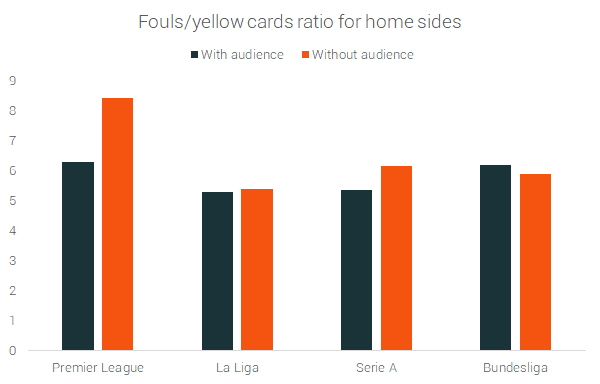
When we talk about the home sides, the Premier League displays the biggest increase from 6.31 to 8.43 (+33.6%). The change in ratios of other leagues is less than 1.
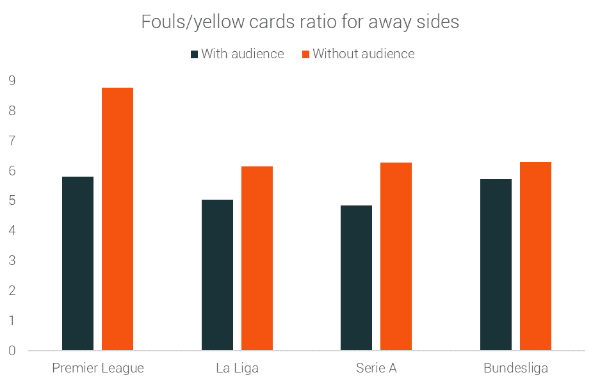
We see a uniform trend when we talk about away sides. The ratio has increased for all leagues meaning that referees are allowing more fouls to away players before brandishing them a yellow card.
In the Premier League, the ratio has significantly increased from 5.81 to 8.77 (an increase of more than 50%). In La Liga, it has increased from 5.05 to 6.15 (+21.8%), and in Serie A, from 4.85 to 6.28 (+29.5%). The change is least significant in the Bundesliga, from 5.73 to 6.29 (+9.8%).
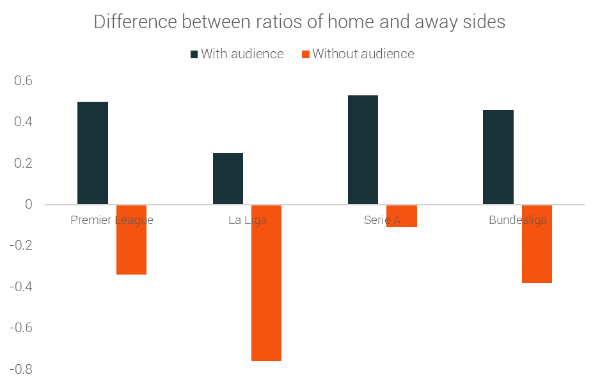
We also compared the ratio of fouls to yellow cards by subtracting the away ratio from home ratio. We can see that with an audience present, home sides have a clear advantage in all leagues.
However, without an audience, that advantage has disappeared and it has turned into a disadvantage. Currently, away sides are being allowed more fouls by referees before they are cautioned with a yellow card.
Conclusion
We can see that referees’ bias towards away sides has completely changed without an audience in stadiums.
Previously, away sides used to get more yellow cards in all leagues, and they also had an inferior fouls to cards ratio. However, without an audience, the disparity has disappeared, and in fact, the trend has reversed in some leagues.
We also notice that referees are giving fewer yellow cards overall and allowing more fouls in three out of four leagues. Only in the Bundesliga, the overall yellow card count has increased post-COVID.
